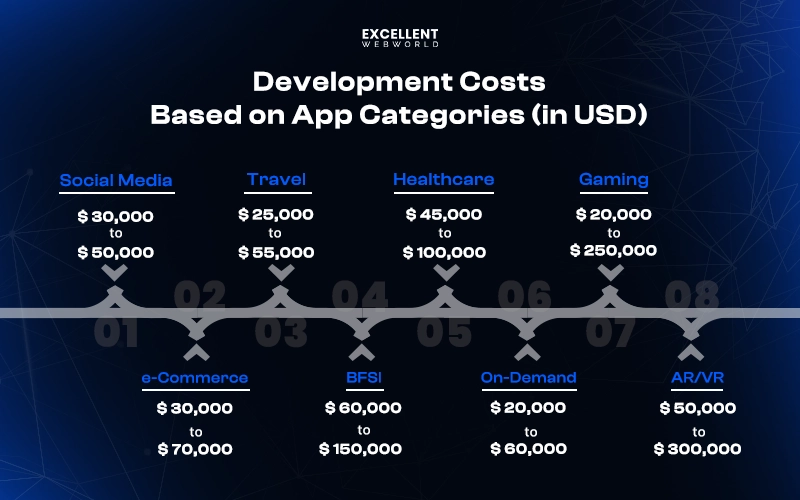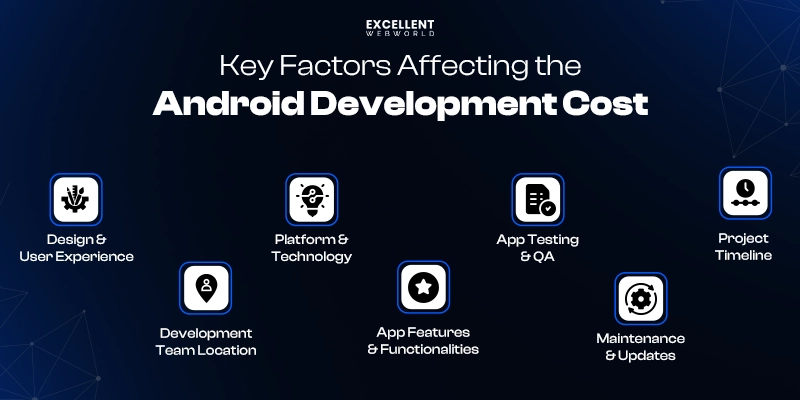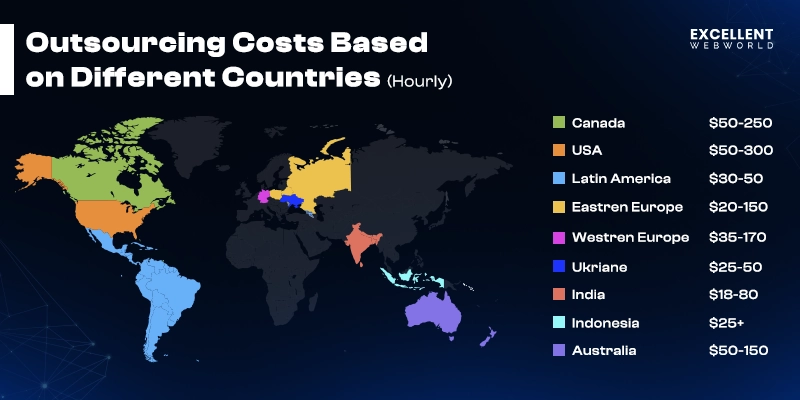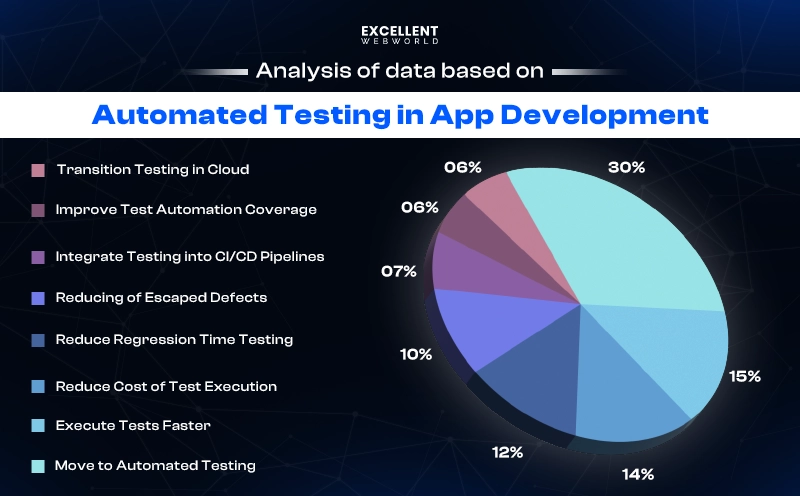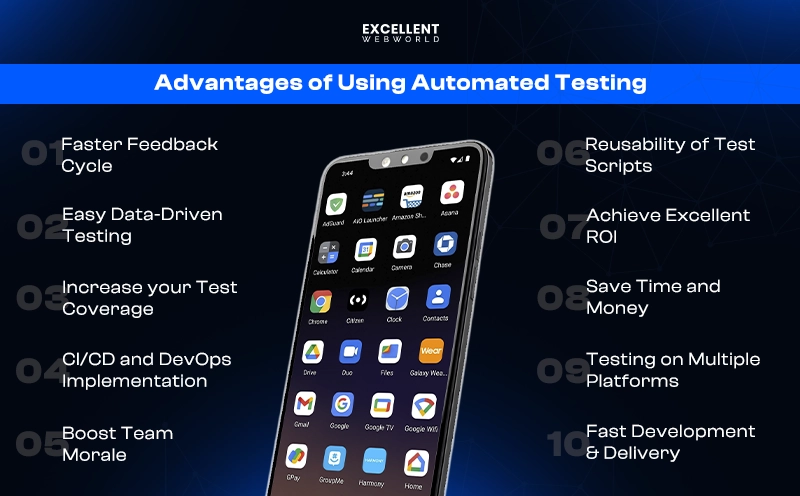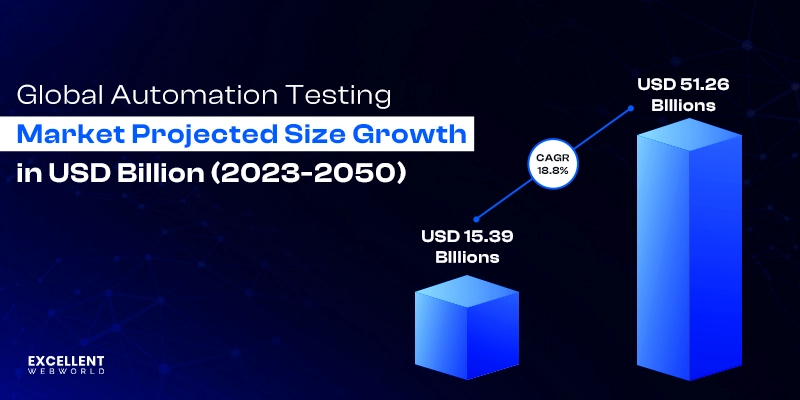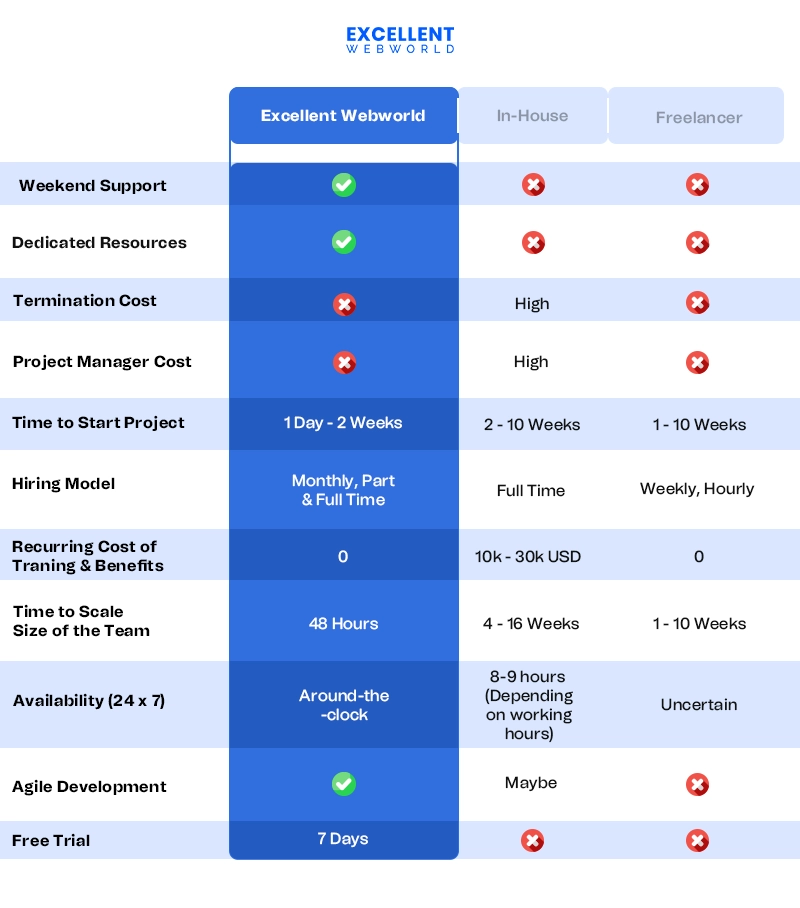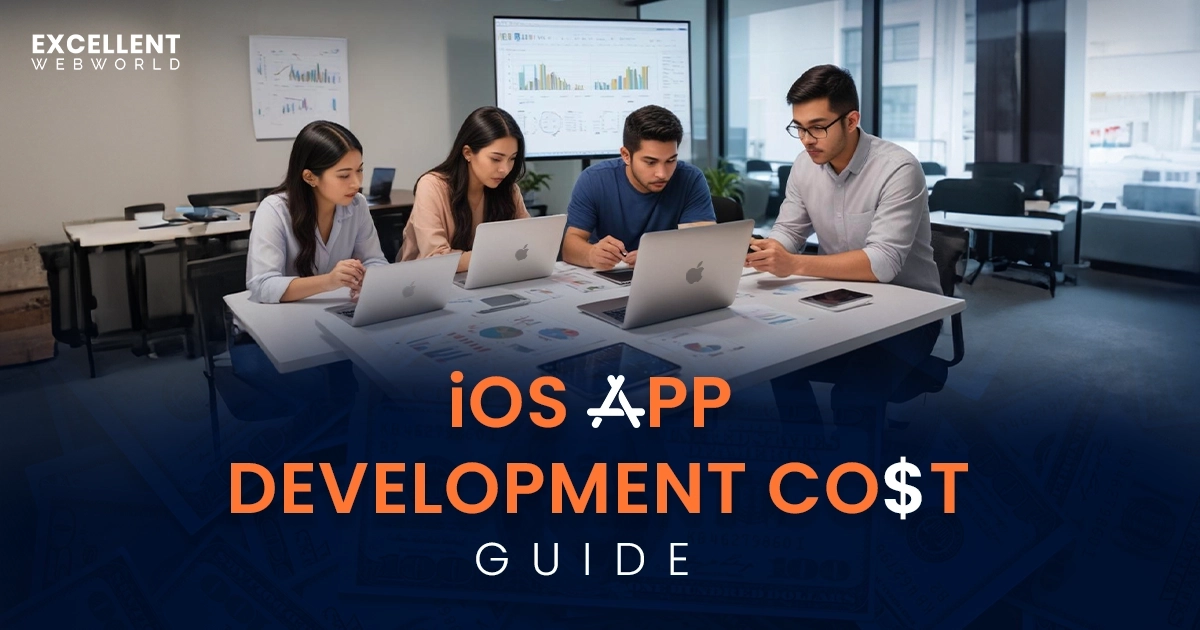Are you looking for the cost of developing an Android app?
Android app development costs usually range from USD 18,000 to USD 300,000 depending on different factors. Mobile app design, feature complexity, integrations, and overall functionality are key factors influencing it. This is why it’s important for you to know them and understand how they impact the cost of developing an app. Moreover, you need to plan the project budget, as development costs account for a major chunk of the overall cost.
In this blog, we’ll explore a comprehensive breakdown of Android app development costs and key factors that influence it. Having this knowledge is essential for effective planning, regardless of whether you’re an enterprise or a small business.
Complexity-Based Android App Development Cost Breakdown
This cost breakdown calculates expenses based on a mobile app’s complexity and features. This will help you understand the costs based on the application design, functionality, backend, and technology.
Here is cost break-down based on app type!
| App Type | Cost Range | Development Duration | Key Features |
|---|---|---|---|
| Basic Apps | USD 18,000 – USD 20,000 | 2-3 months | Simple functionality (e.g., calculator, to-do list) |
| Medium Complexity Apps | USD 20,000 – USD 50,000 | 3-6 months | User authentication, social media integration, APIs |
| High Complexity Apps | USD 300,000 – USD 500,000+ | 6+ months | AR/VR, AI, Blockchain, real-time chat, extensive backend |
While this breakdown offers insights into an approximate range of Android applications, the actual costs will depend on different factors. Each factor caters to various business needs, changing the total cost of ownership for Android apps. Let us see the cost of Android applications based on the categories in the below image.
For example, the cost of designing your Android app will differ from the expense of integrating third-party services into your applications. However, you must consider both when planning app development costs.
Key Factors Affecting the Android Development Cost
The cost of developing an Android app can depend on many factors, including the complexity of features, design requirements, and the development team’s location. So, here are the factors you must consider while calculating Android app development cost.
1. Design & User Experience
Design and user experience (UX) significantly impact application development costs. Simple, minimalist designs typically incur lower expenses. Meanwhile, complex designs with rich animations, such as sliders and various effects, require more resources, which increases the overall costs. The more intricate the design, the higher the app design cost.
2. Development Team Location
The location of the development team significantly impacts the cost of developing an Android application. In the United States, rates range from USD 70 to USD 200 per hour. Whereas in regions like India and Mexico, rates are more affordable, such as USD 20 to USD 80 per hour. Hiring a development team based on expertise and budget can significantly influence the overall cost.
3. Platform & Technology
Platform and technology are key factors in Android app development costs. Native Android apps built specifically for the platform using tools like Java or Kotlin require separate development for each version, which increases costs.
The cost of hiring Android app developers increases with the choice of advanced technology. For example, the choice of technologies, such as third-party APIs, cloud services, and advanced features like AI or AR, impacts development time and resources. More complex features and integrations also result in higher costs.
4. App Features & Functionalities
The cost of developing an Android app depends on its complexity and features. Essential apps with simple functions like navigation and data storage are more affordable.
However, advanced features like real-time updates, third-party integrations, payment systems, and AI/ML functionalities can significantly increase costs. Custom features and ongoing maintenance further add to the development expenses.
5. App Testing & QA
App testing and quality assurance (QA) are crucial factors in determining the cost of Android app development. They ensure your app functions smoothly across different devices and operating system versions. These processes help identify and fix bugs, improve performance, and enhance the overall user experience, all essential for a successful app launch.
6. Maintenance & Updates
The costs of updates and maintenance for Android app development can vary. Post-launch maintenance ensures the app remains functional and compatible with new operating systems. Updates, which are essential in app development, may add features, fix errors, and improve performance.
Top app maintenance service providers such as Excellent Webworld ensure the app runs smoothly with consistent testing and upgrades.
7. Project Timeline
The project timeline for Android app development plays a significant role in determining costs. Businesses often need quick turnarounds to stay ahead of competitors, align with Android app trends, or capitalize on events like product launches or holidays. This urgency, known as time-to-market, can drive up costs due to added resources, overtime, and tight coordination.
However, a well-planned timeline with sufficient buffer periods allows for efficient development, thorough testing, and better budget control. Striking a balance between urgency and planning helps optimize costs while delivering a high-quality app.
Hidden Costs Associated with Android App Development
When planning Android app development costs, it is quite essential to consider additional expenses that can impact the overall budget. Key areas to focus on include:
1. App Marketing & Launch
Once your Android app is developed, marketing campaigns must promote it and highlight its user benefits. From a marketing perspective, various expenses include paid advertising and app optimization. The cost of Android mobile app development and marketing are closely linked. Top app marketing agency like Excellent Webworld helps you to scale your app with cost-effective marketing strategies.
2. Legal & Licensing Fee
Intellectual property (IP) protection and privacy policies are associated with Android app development costs and can vary significantly. Depending on the app’s nature, license fees may range from USD 5,000 to USD 50,000. These legal and licensing fees are primarily for ensuring the safety and security of the app’s data, which affects the overall price.
3. Third-Party Services & API
Integrating third-party applications and APIs into Android app development can upscale the functionality and impact the Android app development cost. Depending on complexity and usage, the costs can vary significantly when integrating third-party services into Android app development. For example:
These third-party service expenses should be carefully considered when estimating the overall cost of Android app development.
Cost-Saving Strategies for Reducing Android App Development Costs
Several methods can be employed to achieve cost savings in Android app development. The primary cost-cutting measures implemented to lower the high expenses of developing Android apps include:
1. Integrating a Minimum Viable Product in Android Development
While Minimum Viable Product (MVP) addresses the cost for the user’s needs, it helps in testing the market by simply launching a light version of the application. Gathering feedback before investing can help reduce unnecessary costs for your Android app.
2. Prioritization of Features
Focusing on essential features during Android app development ensures success and helps control costs. Avoid including all possible features in the first version to save money. By prioritizing core functionalities, you can optimize resources and avoid unnecessary expenses.
3. Selection of the Right Technology for Development
The right mobile app development technology, such as cross-platform frameworks like Flutter or React Native, can significantly reduce Android mobile app development costs. These frameworks streamline the process by enabling efficient code creation and help maintain a proper development timeline.
4. Agile Development Approaches
Agile methodology helps reduce Android app development costs by enabling teams to work in short, iterative cycles. This approach allows for quick adjustments based on feedback, avoiding unnecessary expenses and optimizing the budget effectively.
5. Outsourcing in Other Regions
Outsourcing enables companies to access expertise at a lower cost than maintaining an in-house team. This is particularly beneficial for activities such as UX design and quality assurance. Outsourcing costs vary by country and can depend on the stage of development. You can get quality work at the lowest prices by outsourcing to a top mobile app development company like Excellent Webworld.
The below table below shows the differentiation between in-house and outsourcing development.
| Aspect | In-House Development | Outsourcing Development |
|---|---|---|
| Cost | Higher (hiring, tools, training). | Lower (pay for services). |
| Expertise | Limited to internal skills. | Access to specialized experts. |
| Flexibility | Less flexible for scaling. | Highly flexible and scalable. |
| Timeline | Longer due to the hiring process. | Faster with ready professionals. |
| Maintenance | Managed internally ongoing costs. | Often included in the contract. |
| Infrastructure | Requires investment for the office space, hardware, and software tools. | No infrastructure costs. |
6. Automated Testing
Automated testing reduces Android app development costs by saving time, identifying errors, and improving scalability.
It enhances performance, security, and navigation, leading to faster delivery and lower expenses. Automated testing has many advantages in the mobile app development stage.
The global automation testing market is expected to grow from USD 15.39 billion to USD 51.26 billion by 2030 at a CAGR of 18.8%, ensuring continued high-quality mobile app development. Let’s see the data based on automated testing in mobile app development.
Develop High-Quality Android Apps with Excellent Webworld Team
We hope this article has highlighted the importance of partnering with the right team for Android app development. Experts like Excellent Webworld can significantly impact your app’s success, providing tailored solutions that align with your business goals.
Excellent Webworld offers innovation, scalability, and comprehensive support from ideation to post-launch, optimizing app quality and development costs. With years of experience in the Middle East, the US, and India, we specialize in creating user-friendly, scalable apps using agile processes and advanced technology.
Whether you’re a SMB or an enterprise-grade business, Excellent Webworld, a Clutch-certified leading Android app development company, ensures your investment in app development is cost-effective, delivers value, and supports growth in local or global markets. Partner with us to bring your app idea to life while staying within budget.
FAQs
Publishing an app on Android costs a one-time fee of USD 25 for a Google Play Developer account.
The hourly rates for hiring an Android app developer typically range from USD 70 to USD 200 in the USA, while in Asian countries like India, it costs around USD 20 to USD 80, with the rest depending on the developer’s experience.
The development time varies, but depending on its complexity, a fully functional Android app typically takes between 2 and 6 months to build.
The cost is estimated based on app complexity, features, design, integrations, and the development team’s location and expertise.
Ongoing costs include app maintenance, updates, hosting, third-party service fees, and marketing, which ensure your app stays functional and competitive.

Article By
Mahil Jasani began his career as a developer and progressed to become the COO of Excellent Webworld. He uses his technical experience to tackle any challenge that arises in any department, be it development, management, operations, or finance.

